
A composting method used on the organic farm run by Illinois farmer Joel Rissman, which involves controlled microbial composting, has worked out well for the operation, and could easily be applied to mid-sized and large beef operations.
A composting method used on the
organic farm run by Illinois farmer Joel Rissman, which involves
controlled microbial composting, has worked out well for the operation,
and could easily be applied to mid-sized and large beef operations.
One stereotype of organic farm owners—a stereotype that is now wildly out of date, it should be noted—is that they are “weekend farmers” or perhaps even aging hippie types who dabble at organic products. That stereotype is easily blown away by Illinois farmer Joel Rissman.
Rissman has taken a very pragmatic and professional approach to organic farming and manure management on his beef and crop operation near Waterman, Illinois, about an hour west of Chicago. That approach has provided his farming business with a steady income and also protected the livestock operation against nuisance lawsuits in a farming area that has become increasingly urban. And while his is a relatively small cattle operation, Rissman says the composting method he employs could easily be used on large and mid-sized beef operations.
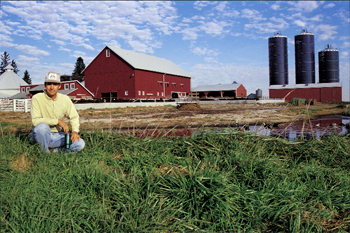 Joel Rissman has taken a very pragmatic and professional approach to manure management and organic farming on his beef and crop operation near Waterman, Illinois. Joel Rissman has taken a very pragmatic and professional approach to manure management and organic farming on his beef and crop operation near Waterman, Illinois. |
Rissman came to farming in 1991 with a very strong, ag-related background. Coming from a farm family, he took the agricultural mechanic program at an Illinois state college in the 1980s, and followed that with three years as a mechanic at a John Deere dealership. After working in the Peace Corps, he then went to the University of Illinois, where he earned a degree in Agricultural Engineering.
Rissman started farming 370 acres of family-owned land near Waterman in 1991, and quickly saw that a conventional farming operation on that scale was a break-even proposition, at best. “We weren’t making any money—and I fell into the paradigm of having an off the farm job. I was working 40 or 50 hours at a job and then coming back home to try and get all the farming done.”
A willingness to look for a better way to farm, along with an aversion to using chemicals, spurred him into starting the conversion to organic in 1993. The farm has been fully organic since 1996.
The manure management system is a critical part of any livestock operation, but perhaps even more so with an organic farm. After reviewing a number of different composting methods and discussions with composting consultant Edwin Blosser of Midwest Bio-Systems Inc, Rissman opted for the Luebke method, which involves controlled microbial composting. Temperatures, moisture levels and carbon dioxide are all closely monitored with the Luebke system.
“I read up on the Luebkes,” Rissman explains. “Their farm was in the path of Chernobyl and by using this compost system they had one of the first farms to be free of radium. That’s pretty powerful cleansing.”
With the help of a modest Sustainable Agriculture Research and Education (SARE) grant, Rissman built a composting pad and containment pond right behind the cattle yard. SARE is a program of the USDA’s Cooperative State Research, Education and Extension Service.
It’s a relatively simple process: the sheds are bedded with straw. To save having to put calcium on his soil, Rissman puts a two-inch layer of high calcium lime on the cement floor, under the straw. When the sheds are cleaned out, the straw/manure mixture is moved to the composting pad.
Every two weeks, Rissman sprays the bedding with a product called Effective Microorganism (EM). EM does two jobs: it helps to tie up the nitrogen, reducing ammonia odors, and it controls flies since they do not want to lay their eggs once the EM is applied.
EM is also a compost starter. “We did some trials, one with EM and one without,” explains Rissman. Going into the sheds to move the material with their John Deere 2030 loader and Case 1835 skid-steer loader, the bedding without EM was matted and locked together. They’d have to dig into the bedding two or three times to get a bucket load. “With EM, the long strands of straw in the bedding were being broken down, it wasn’t matted—the breakdown process had already started.”
Run-off from the feedyard had been a problem in the past. But now run-off is routed to the containment pond, and it is pumped back on the compost piles to keep the material moist.
“More importantly, the five to ten acres that had been affected by run-off in the past, and had been weedy, has now become productive farmland.
“Composting also helps with overall weed control,” explains Rissman. Through the biological process, most of the weed seeds are broken down. “We don’t have as many weed problems as you’d have hauling raw manure.”
The initial plan for the composting pad was to put down four inches of limestone. But they found the limestone base got too mushy in the spring. “So we put in a three-inch crushed rock base, then covered that with limestone, and that worked beautifully,” says Rissman.
Turing the compost is an Aeromaster ST 300 compost turner from Midwest Bio-Systems, which Rissman says has served them well, and requires little in the way of maintenance.
With this smaller operation, space is at a premium. “The beauty of the system is that we have a quick turnaround in manure so you don’t have to devote a lot of space to it,” says Rissman.
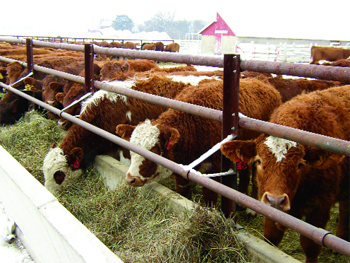 Compost from the Rissman farm is applied to help grow organic corn, soybeans, oats, wheat, barley and alfalfa. A portion of the crops is fed to the organically-produced beef cattle. Compost from the Rissman farm is applied to help grow organic corn, soybeans, oats, wheat, barley and alfalfa. A portion of the crops is fed to the organically-produced beef cattle.
|
Composting 1,500 tons of raw manure required a pad and pond that, together, required less than an acre. Setting up four rows generates “about 500 tons of finished perfect compost” in eight weeks time, that is applied to help grow organic corn, soybeans, oats, wheat, barley and alfalfa. They feed a portion of their crops to the organically produced beef cattle, as well as to broilers, turkeys and layers.
The composting material is turned once a day for the first week, every other day for the second week, and every third day for the third week, with fewer turns required right through to the eighth week. Throughout, temperature, moisture and carbon dioxide levels are measured. The four piles, five feet tall by 10 feet wide by 100 feet long, can be turned in less than 30 minutes with the Aeromaster turner. The volume is considerably reduced; at the end of eight weeks, the compost has a volume about one third of what the raw material had.
One of the few problems they initially ran into was the windrow covering. They originally used a fleece covering—which allowed an exchange of gases—to keep water off the composting material. “But in the winter, the water would run down and freeze on the lower edge. It was a nightmare pulling the covers off to turn the compost.” They opted to biodynamically treat the manure during the winter months, a static situation that does not require turning.
Having tight control over moisture is key to the process, he notes. “If you were to get a two or three inch rainfall, which is what we seem to be getting these days, it can kill the pile and make the whole thing go anaerobic.”
Rissman notes that their system is very soil friendly. They are not going over any pastureland moving the manure to the pad, and hauling out the compost to the field for spreading with a Knight 1040 spreader leaves a light footprint. There are also fuel savings since the volume being hauled is much reduced.
This past year, Rissman had 144 head, but he noted that the method could easily work for larger feedlot operations. For the typical dry feedlots in the Plains states, “this would be ideal”. He added that it has been successfully used on feedlots in Texas.
Notably, there is no smell with the compost. The farm is 50 feet across the road from a neighbor’s house, and there has not been a single complaint about odor.
For the Rissman farm, with growing residential development around it, that lack of odor is a huge consideration. “With composting, there will be a three- day window with some smell, with some volatile gases because things are changing over from anaerobic to aerobic, but once you get the piles switched over and heating well, it all goes away.”
In general, he notes that many farms do not utilize all the available tools when it comes to a real industry issue: reducing odor.
“There are a lot of easy, simple things they can do to take themselves off the radar screen, like using a biological product. When you look at the hundreds of thousands of dollars invested in manure management set-ups, to set aside a thousand dollars to get some biological products that will help tie up these gases and emissions in pits is not a big thing. Sometimes the solution can be relatively cheap.”
Considering the rising cost of commercial fertilizer, there are significant cost savings there for the farm in using compost. “I do all my fertility with the compost,” says Rissman. He estimated his savings to be at least $10,000 a year.
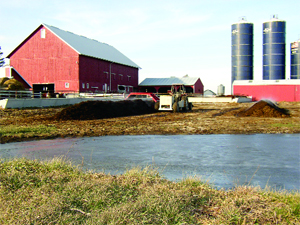 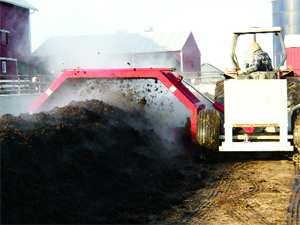 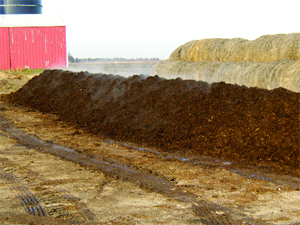 Turning the compost is an Aeromaster ST 300 compost turner from Midwest Bio-Systems. The four piles, five feet tall by 10 feet wide by 100 feet long, can be turned in less than 30 minutes with the Aeromaster turner. Turning the compost is an Aeromaster ST 300 compost turner from Midwest Bio-Systems. The four piles, five feet tall by 10 feet wide by 100 feet long, can be turned in less than 30 minutes with the Aeromaster turner. |
The composition of the compost can also be tweaked. If Rissman tested the soil and found it needed some potassium, he would sprinkle some potassium sulphate on the bedding manure mix in the sheds. He notes there are advantages in nutrient uptake, too, in that compost is immediately available to the plant. “When you’re putting down raw manure, it has to be broken down first before the plant can uptake any nutrients. Compost is immediately plant available, if you’ve done it properly.”
Setting up the organic farm took three years—certification is only available three years after the last use of prohibited chemical fertilizers, which includes most N, P and K fertilizers and insecticides. The farm records, and land, are inspected every year, as part of the ongoing certification.
While National Organic Program certification—which Rissman has—is the seal of approval for organic operations, the proof is in the doing, and Rissman has hosted many of his customers at the farm to show them exactly what he is doing. The University of Illinois Manure Tour has also made a stop at the farm.
Rissman has been pleased with his organic operation, but this particular farm is coming to an end. The 300 acres he has been farming has been sold for residential development. The “Chicagoland” area has been growing quickly in recent years, and nearby towns like Waterman have become far more suburban than rural.
But on the flip side, being so close to such a large urban center has meant a ready market for his organic beef over the last decade. “I’ve had the luxury of being right on the threshold of eight million people, so it hasn’t been hard to market our beef and chicken.”
A great help on the marketing side has been the Dakota Beef Company, a South Dakota-based operation that sells certified organic beef products. The Rissmans were one of the first certified organic livestock producers to sell cattle to Dakota Beef.
“That has really helped us,” he says, noting that Dakota Beef has farm suppliers throughout the Midwest, which is encouraging. “Wherever I locate—and I could be in a far corner of a state with no cities around—by selling to Dakota Organics, I can still raise and sell beef at a profit.”
There is a growing demand for organic beef, which has other producers eyeing that market. The market pays a premium for organic beef, but Rissman emphasizes that it has to be high quality. “The whole organic market is based on quality. The companies involved are not just going to buy anything that has four legs and goes ‘moo’.”
Rissman is now committed to organic farming. “We’re moving, and I don’t know where, but I’ll be farming organic whether it’s a small operation or a 1,000-acre feedlot.
“I’m not against large operations,” he says. “But there is a way to do it
that is good for animals and the environment.”